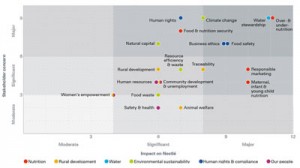Measuring what matters: Nestlé’s materiality matrix
- Like
- Digg
- Del
- Tumblr
- VKontakte
- Buffer
- Love This
- Odnoklassniki
- Meneame
- Blogger
- Amazon
- Yahoo Mail
- Gmail
- AOL
- Newsvine
- HackerNews
- Evernote
- MySpace
- Mail.ru
- Viadeo
- Line
- Comments
- Yummly
- SMS
- Viber
- Telegram
- Subscribe
- Skype
- Facebook Messenger
- Kakao
- LiveJournal
- Yammer
- Edgar
- Fintel
- Mix
- Instapaper
- Copy Link
Posted: 24 March 2015 | Victoria White | No comments yet
Each year, Nestlé’s materiality matrix plots the economic, social and environmental issues against the the company’s reputation, operations and finances…


Each year, Nestlé creates a materiality matrix, plotting the economic, social and environmental issues of most concern to stakeholders against the impacts they may have on the company’s reputation, operations and finances.
After extensive consultation both inside the company and with stakeholders on the outside, the most important issues identified are placed on a grid that displays their position relative to the degree of concern for stakeholders and the potential impact on Nestlé’s business.
The analysis considers where the financial, operational and reputational impacts would be felt strongest in Nestlé’s value chain.
Materiality matrix allows investors to know if a company understands societal risks
The company’s Head of Public Affairs Janet Voûte believes the matrix is not just useful for ‘social’ audiences, but for the financial community too: “If you are a socially responsible investor you want to know whether this company is well run, and whether it understands societal risks and how they impact the business.”
The new materiality matrix, published next month in the full “2014 Nestlé in society: Creating Shared Value” report, emphasises the priority both Nestlé and its stakeholders place on addressing global challenges such as over and under nutrition and water stewardship.
It also highlights acute stakeholder concern over climate change, natural capital and human rights, as well as Nestlé’s growing understanding of the potential business impacts (both risks and opportunities) of these and other issues, including animal welfare and food waste.
As well as presenting strategic and operation challenges for Nestlé, these issues can also provide commercial opportunities for the company. For example, ensuring the safety of the global food supply chain is a cost, requiring investment in R&D and monitoring to ensure products are safe, but also an opportunity, as brands that are trusted as safe, and high quality, do better in the market place.
The materiality matrix assists Nestlé in delivering on their “2014 Nestlé in society: Creating Shared Value” summary report, ensuring the document meets the needs of different stakeholders looking for information about the company’s activities, rather than just concentrating on areas where there is a ‘good’ or ‘positive’ story to tell.
Nestlé believes the matrix ensures that their actions, and the consequences of these actions, are highly visible, helping the company to connect with different stakeholders, to show transparency and build trust. It also helps frame the 38 public commitments Nestlé has made that guide management and different parts of the business in their collective efforts to create shared value for shareholders and for society.
Nestlé recognises that more quantifiable evidence is needed to demonstrate the value delivered by linking business performance and social impact, and there is work going on inside the company to address this. The challenge, according to Nestlé Chairman Peter Brabeck Letmathe and Chief Executive Officer Paul Bulcke, “is to find a consistent method of measuring the business value of Creating Shared Value, as well as to assess societal impacts and not just activities.”
For the “2014 Nestlé in society: Creating Shared Value summary report”, please visit www.nestle.com (pdf, 4Mb).





